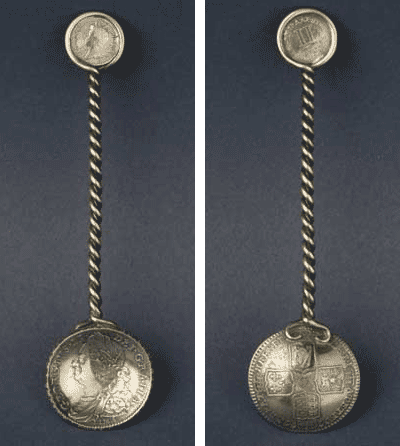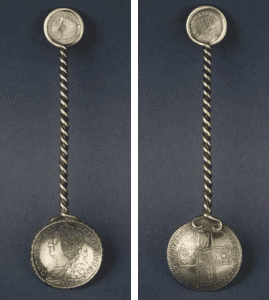Of Spoons and Empires

The political uses of silver in provincial New York
The professional study of early America has created a host of subfields whose literatures often do not intersect. Nowhere is this more evident than in the relationship between those who study the period’s material culture and those who examine its politics. The distance between these subdisciplines often seems so great that it becomes difficult to remember that those living in the eighteenth century did not perceive themselves or their world in the way that we who study them do—as a series of disparate activities corresponding to our various scholarly rubrics. Instead, their reality was much like our own: values and beliefs learned and professed in one aspect of life seamlessly shaped behavior in all other realms of existence.
It is with this understanding that we should view a silver communion spoon, which is part of the New-York Historical Society’s collections. The specific structure of this spoon, presumably used in the mid-eighteenth century during communion services in the Church of England, reflects, I believe, a profound and previously ignored change in historical and political understanding that occurred in the period. The spoon bears two royal images: George II’s profile in the bowl (with national coats of arms of the four nations of the British Isles—England, Ireland, Scotland, and Wales—on the reverse) and James II’s profile in the handle. These royal images visually link the Stuart dynasty, the most reviled of English monarchs, to the Hanoverian dynasty that had assumed the British throne in 1714.
It is possible that this construction was incidental. The bowl and the handle were formed from coins that bore the respective monarchs’ images. But it seems more likely that either the silversmith, or the person who ordered the spoon, made a conscious decision of political imagination. The unknown artisan united two monarchs separated by decades and by the dynastic upheaval of the Glorious Revolution (1688-89) via a silver braid. There were all kinds of coins in circulation in the colonies whose silver might have been used for this sort of item, and the person or people who commissioned the spoon might have asked to have coins melted down and repoured in the desired form. But they did not. They fashioned the spoon in such a way that the images of the coins became integral to the object.
The choice of George II’s likeness for ceremonial use in provincial America is hardly surprising. He ruled over the empire for thirty-three years, headed the Church of England, and was, by the time of his death in October 1760, the only king a majority of colonials had any living memory of. Contemporary British politicians and subsequent generations of British historians have understood him as a boorish German who attempted to assert royal prerogative at the expense of Parliament, involved Great Britain in a series of continental wars to protect his Hanoverian possessions, and quarreled constantly with his popular son Fredrick, Prince of Wales. But colonials viewed him as a benevolent Protestant monarch who acted as the guardian of pan-European Protestantism and who had risked his life in combat against the hated French at the Battle of Dettigen in 1743. It is now difficult for us to imagine the intensity of their attachment to this distant monarch, but it was real and well remembered even after his death. As late as May 1776, the South Carolinian William Henry Drayton would declare during a public denunciation of George III that “the virtues of the second George are still revered among us—he was the father of his people.”
Less obvious is the reason for the linking of George II’s image to that of James II, the openly Catholic, Stuart king overthrown in the Glorious Revolution. In the eighteenth century, James II vied with Edward II for the title of most hated English ruler—ever! But again, placed within its specific historical and political context, the linkage of George II and James II makes sense. Beginning in a restrained way since the reign of William and Mary, Britain’s post-1688 rulers sought to connect themselves genealogically to the same Stuart kings whose politics and religion they had vilified. Even after James II’s overthrow in 1688, Britain’s subsequent rulers simply could not ignore the hereditary principles central to European society. Indeed, they went to great pains to establish the blood links between themselves and the Stuart kings. It thus became a central tenet of colonial political culture that the Hanoverian kings, whose claims to the British throne rested largely on their Protestantism, were of Stuart descent through one of James I’s daughters.
This political-genealogical linkage manifested itself in print as well as in religious cutlery during the so-called Z debate in Pennsylvania, which occurred at the time of the Zenger sedition crisis in New York. When Z, a writer for the Pennsylvania Gazette (probably John Webbe), attacked the Stuart family and asserted that sovereignty resided in the people, a number of writers rebuked him for his continued hostility to “that royal race.” “Must he be told,” one writer asked, “over and over again, that it borders on disloyalty to treat the Memory of our Present gracious Sovereign’s Ancestors, with so much Spite?” Were not such performances “designed to advance new Seditious Doctrines, and revive old ones, to the lessening of the Prerogative of the Crown, under pretence of maintaining the Rights and Liberties of the People?” The Stuarts “were in many things misled by corrupt Ministers . . . into errors and irregularities in their civil Administration.” But he insisted that they were not all papists and commended James I and Charles I for their loyalty and piety. “Our Present gracious Sovereign’s ancestors”—this was the political-genealogical orthodoxy that became a ligament holding together a far-flung empire personified in the Hanoverian kings.
While it might seem odd that a silver spoon would reflect an emergent imperial orthodoxy, in fact it’s not the only silver item from New York City in that period that has a political-religious theme connected to the empire. The Museum of the City of New York’s collections contain a silver beaker, originally imported from Europe, that was redesigned around 1750 to include political-religious images associated with the first British empire’s prevalent anti-Catholicism. The etchings, probably stylized renderings of the Pope’s Day processions (held on November 5 to mark the foiling of a Catholic plot against James I in 1605, now known as Guy Fawkes’s Day) were, like the spoon’s royal images, designed to convey the values of the prevalent imperial political culture. It may be that a particularly politicized silversmith was working in the city; one of the Joseph Leddels (a father and son of the same name had a silver business in the city) etched the beaker, but it is unknown who did the spoon. Or it may be that the intensifying conflict between France and Great Britain—which had led to King George’s War, the Seven Years’ War, and to the 1745 Jacobite rebellion in Scotland (led by James II’s descendent, Bonnie Prince Charlie)—influenced the decorative arts, just as those tensions shaped so much of what occurred in the first British Empire. Certainly, this same time period saw an imperialization of provincial homes in the major ports as print pictures of British royalty, stoneware and delftware carrying imperial arms, and other consumer goods emblazoned with distinctively Protestant and British themes came to be bought and sold in the port towns’ markets.
The design of the communion spoon and the silver beaker reflected the political values that held together the first British Empire. This political culture had at its core the mission of reinforcing the Hanoverian dynasty’s rule over the first British Empire. That imperative saturated colonial society, shaping its public rites, influencing religious life, insinuating itself into all levels of print culture, and ultimately, expressing itself in a spoon or a beaker. It was in this way that a spoon became more than a utensil and became instead a prop of empire.
Further Reading:
Linda Colley has probed the impact of this linking of the Hanoverian dynasty to the seventeenth-century Stuart kings in Britons: Forging the Nation, 1707-1837 (New Haven, 1992). I have taken up the overtly political and imperial character of consumption in my forthcoming book, The King’s Three Faces: The Rise and Fall of Royal America, 1688-1774 (Chapel Hill and Williamsburg, 2006). The Z debate was played out in the Pennsylvania papers in the summer of 1736.
This article originally appeared in issue 6.4 (July, 2006).
Brendan McConville is professor of history at Boston University and the author of The King’s Three Faces: The Rise and Fall of Royal America, 1688-1776 (2006).
